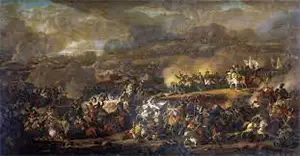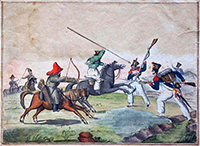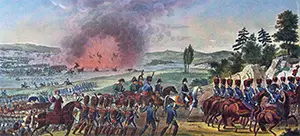The Battle of Leipzig
The Battle of Leipzig was a major victory for the Sixth Coalition against France in October 1813. While the remnants of the Grand Armée staggered back out of Russia after the disastrous Invasion of 1812, the French emperor Napoleon Bonaparte had traveled more quickly back to Paris, amid reports of an attempted coup. He had enough support left in the capital to nullify any challenge to his authority or his crown. In the meantime, however, the other powers of Europe had united against him more than ever before. Joining the Sixth Coalition were Prussia, Russia, Sardinia, Sicly, Sweden, and the United Kingdom. 
France still had a large population (including allies) at this time, and Bonaparte was able to put together another large army, this one numbering 400,000. In May 1813, French troops won two significant battles, at Lützen and Bautzen, involving large total numbers of troops than had yet been seen. The significance for France was that the victories resulted in a cease-fire. However, French losses for both battles combined were about as much as for the Allies. The cease-fire lasted from June to August. During that time, the Allies succeeded in enlisting Austria to join the Sixth Coalition. When the fighting resumed, the French won again, at Dresden. However, the Allied forces scored victories of their own–at Großbeeren, Katzbach, Dennewitz, and (most significantly) Kulm. Bonaparte, his lines of communication and supply threatened, fell back to Leipzig, in Saxony. There, a massive force of Allied forces gathered to do battle. The supreme commander of the Allied force was Tsar Alexander I of Russia. Joining him as nominal heads of their forces were Austrian Emperor Francis I and Prussian King Frederick William III. The entire Allied force arrayed against the French force at the Battle of Leipzig numbered 398,000 men; defending the city of Leipzig and surrounds were about 225,000 men from France and its allies. Significantly, the Allied force had twice as many guns, 1,400 to 700. 
On the first day of the battle, October 16, the two opposing forces hurled themselves at each other in the form of artillery bombardments, cavalry charges, and infantry strikes. Fighting ranged through the various villages in the Leipzig area, and deaths on the first day of battle were numerous. Significantly, despite a hard charge by Marshal Joachim Murat at Liebertwolkitz that nearly succeeded, French forces were unable to break through the Allied encirclement. The second day of battle was relatively quiet by comparison, although a Russian hussar maneuver broke through the French cavalry. At the end of the second day, Bonaparte called for an armistice; he was refused. Also by the end of that second day, a large force of Allied reinforcements arrived. 
The Allied forces threw everything they had at the French force on the third day, October 18. Especially effective on that day were the Bashkirs, descendants of the Mongols who fought for Sussia as they ancestors had, by firing arrows while on horseback. Also helping the Allied cause were the defections of two brigades of forces from Saxony. The battle raged all day and killed tens of thousands on both sides. In the village of Probstheida, 12,000 soldiers died in three hours. On this day as well, fighting raged from street to street, in this village and others. French forces started to run out of ammunition near the end of the day, and Bonaparte ordered a strategic retreat, westward across the Elster River. 
The retreat was still going in the morning when Allied troops discovered it and attacked in full force. Napoleon ordered the destruction of a key bridge across the river in order to forestall pursuit, but French engineers blew it up too early–while some French troops were still on it and before other French troops had reached it. Death came to those who were trapped in Leipzig and to many who tried to swim across the river after the bridge had collapsed. It was the largest battle fought yet in Europe, involving more than 500,000 men. The total number of casualties stemming from this four-day battle has been estimated at nearly 90,000: 73,000 French and 54,000 Coalition. The Coalition total was killed and wounded; the French total included 30,000 captured and 5,000 defected. It was the first decisive defeat suffered by Bonaparte since the Napoleonic Wars began. |
|
Social Studies for Kids
copyright 2002–2025
David White




